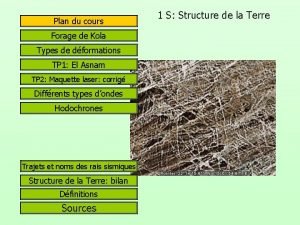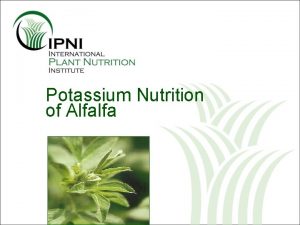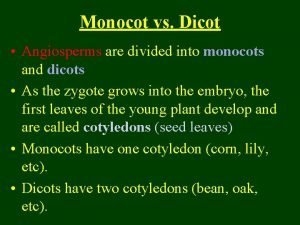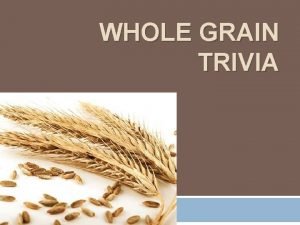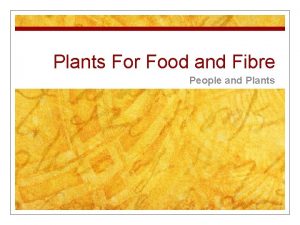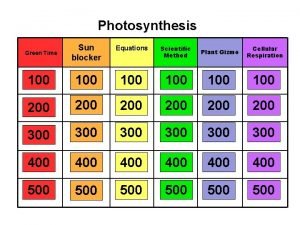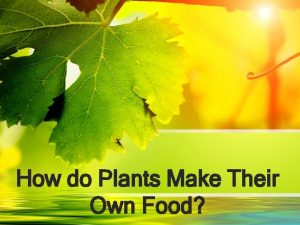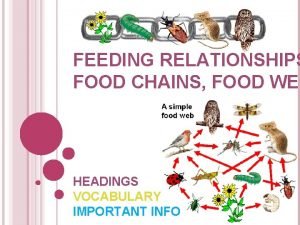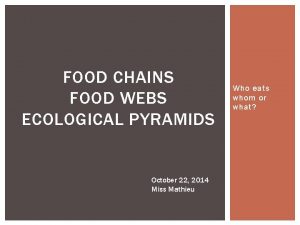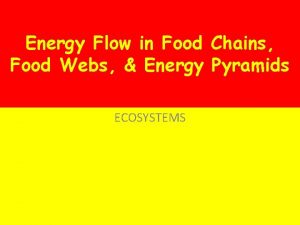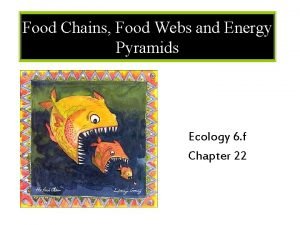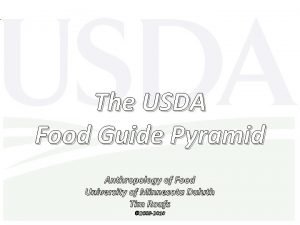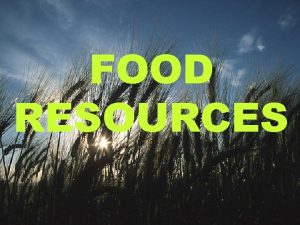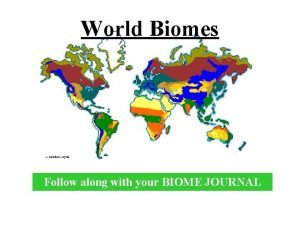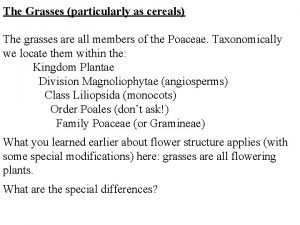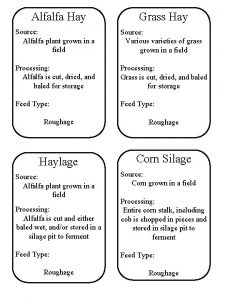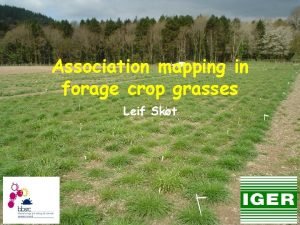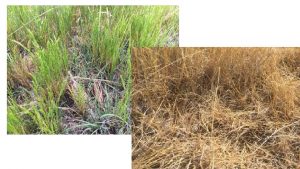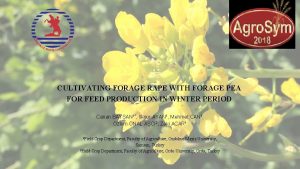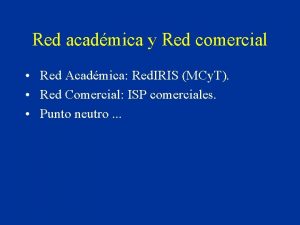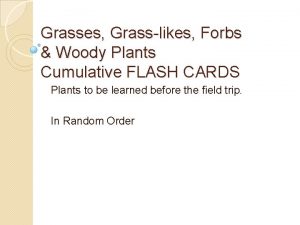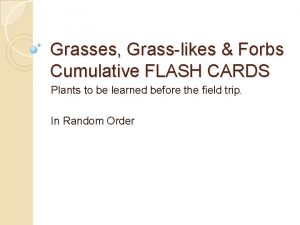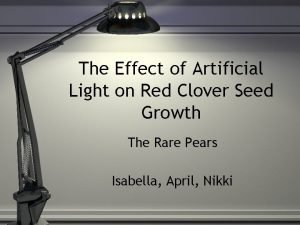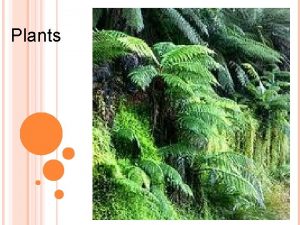Food Plants Forage Grasses Alfalfa and Red Clover




















































































- Slides: 84

Food Plants

Forage Grasses

Alfalfa and Red Clover – Legumes, not grasses

Kentucky Blue Grass

Timothy – Phleum pratense

Fescues – Festuca sp.

Big Bluestem – Andropogon gerardii

Little Bluestem – Andropogon scoparius

Blue Grama – Bouteloua gracilis

Switchgrass – Panicum virgatum


Legumes

Legumes • Legumes are members of pea, bean family (Fabaceae) and are very important sources of food due to their highly nutritious seeds • Legume seeds are very high in protein due to the nitrogen fixing root nodules with which legumes can extract N 2 gas to make ammonium which they use when synthesizing protein


Protein content various foods

Soybeans

Soybean – Glycine max

Tofu – Bean Curd

Soy milk

Soy sauce

Edamame

Miso – soybean paste

Starchy Staples

Top agricultural products, by crop types (million metric tons) 2004 data Cereals 2, 263 Vegetables and Melons 866 Roots and Tubers 715 Milk 619 Fruit 503 Meat 259 Oilcrops 133 Fish (2001 estimate) 130 Eggs 63 Pulses 60 Vegetable Fiber 30 Source: Food and Agriculture Organization (FAO)[

Top agricultural products, by individual crops (million metric tons) 2004 data Sugar Cane 1, 324 Maize 721 Wheat 627 Rice 605 Potatoes 328 Sugar Beet 249 Soybeans 204 Oil Palm Fruit 162 Barley 154 Tomato 120 Source: Food and Agriculture Organization (FAO)

Plant Storage Organs Some examples of storage organs in plants: (a) tap root of carrot (Daucus carota); (b) bulb of onion (Allium sp. ); (c) corm of crocus (Crocus sp. ); (d) rhizome of iris (Iris sp. ); (e) root tuber of dahlia (Dahlia sp. ); (f) stem tuber of potato (Solanum tuberosum).

Plant Storage Organs • Rhizomes – are horizontal stems that are underground – reduced scale-like leaves are present on the surface of the rhizome and adventitious roots form on its underside – buds found at the nodes can give rise to new plants – ginger and iris • Tubers – are enlarged storage tips of a rhizome – the white potato is a tuber – the eyes of a potato are actually buds located at its nodes and each bud can give rise to a new plant • Bulbs and Corms are modified stems found in monocots – Bulbs are erect underground stems with both fleshy and papery leaves; food is stored in the fleshy leaves – Onions, tulips, daffodils, hyacinths, and lilies all have bulbs

Plant Storage Organs • Corms store food reserves in the stem, not the leaves – they are erect underground stems are covered only with dry papery leaves – corms can multiply by producing small corms – plants with corms are gladiolus, crocus and taro • Tuberous roots are modified fibrous roots that have become fleshy and enlarged with food reserves – they can also function in asexual reproduction – tuberous begonias, dahlias and sweet potatoes • Taproots may also function as food storage organs – especially for biennial plants like carrots, rutabaga and turnips

Starchy Rhizome - Ginger

Tuber – White Potato

Tuber – Planting Seed Potato

Bulb – the Onion

Bulb – Tulip with Offsets (new bulbs)

Corm - Gladiolus

Tuberous Roots – Sweet Potato

Taproots – Carrots and Turnips

For Love of the Potato

New Foods to Europe • Alfred Crosby has gathered data which suggests the introduction of maize and potatoes alone allowed the doubling of Europe’s population in the period after Columbus’ discovery of America • Corn was important because of the very high yields possible from corn agriculture

New Foods to Europe • Potatoes were important because, unlike corn, they provided a complete set of amino acids (corn lacks lysine) - potatoes were great for poor people in Europe because they can be easily grown in areas of poor, depleted soil, they will grow well during a short growing season (typical of northern Europe) and they can even be left in the ground if necessary, so they are less sensitive to the timing of the harvest than competing poor-soil crops, such as rye, which must be harvested when the seeds are ripe or it will rot

The Potato Comes to Europe • The potato came to Europe about 1565 - at first, most people in Europe, including the Irish, used the potato as a back up for grain production, but by the end of the 17 th century, it had become an important winter food; by the mid-eighteenth century it was a general field crop and provided the staple diet of small farmers during most of the year

Ukrainian Food Potato Pancakes Borsch

Potato Vodka

Benefits of the Potato

Van Gogh – The Potato Eaters


Cartoon of Irish “Bogtrotters” circa 1840’s

Young potato plant with early stage of late blight

Dried potato leaf infected with late blight – Phytophthora infestans

Potato tubers with Late blight

Potato field infected with late blight – Infection started in center of field


Severity of blight and famine

Irish family digging Potatoes - 1847

Irish family potato dinner - 1846

Irish food riots - 1847

Irish food sent to England – 1847 or 1848

Lessons learned? “Whatever may be the misfortunes of Ireland, the potato is not implicated. It, on the contrary, has more than done its duty, in giving them bones and sinew cheap. . . There is no other crop equal to the potato in the power of sustaining life and health. ” - Bain 1848

Sweet potato tuberous roots

Origin of Sweet Potato • Sweet Potato – Ipomoea batatas – was first domesticated in Peru about 5 or 6 thousand years ago – its culture spread through out South and Central America and the Caribbean region • The Arawak People called it batata which became corrupted into the word potato • It was brought to Europe by Columbus around 1500

Sweet Potato – Ipomoea batatas

Sweet Potato • Sweet potato is a tuberous root cultivated by vegetative propagation (cuttings) • It was a staple food throughout the Americas and also across the Polynesian islands – big question is how did it get to Polynesia – by people or by accident?

Plans for a balsa wood raft – used along coast of South America -drawn by F. E. Paris in 1841

Thor Heyerdahl’s balsa wood raft – 1947 in action and model

Possible Inca route to Pacific Islands and Kon-Tiki route

Polynesians to South America? • It is more likely that Polynesians crossed the Pacific and obtained sweet potatoes directly from the South Americans • In most parts of the South Pacific, sweet potatoes are called kumara, very similar to the Peruvian word of cumara • However, in Hawaii, the sweet potato is called ‘uala, more similar to the Columbian word kuala - perhaps a couple of groups were in contact with South America

Polynesian Ships in Tahiti

Sweet Potato Agriculture • Sweet Potato is rich in carbohydrates, vitamins and minerals – some of the carbohydrates are in the form of sugars rather than starch, hence the sweet taste • About 50% more calories than white potato, but slightly less protein • Two main varieties – a drier, starchier yellowfleshed variety and a moister, sweeter, deeper orange variety • China dominates sweet potato cultivation, but also important in Japan and several African countries; increasing production in US

Sweet Potato Cultivation

Manihot or Cassava – Manihot esculenta

Cassava • Cassava (Manihot esculenta), also called yucca or manioc, is a woody shrub of the Euphorbiaceae family • It is cultivated as an annual crop in many parts of the tropical world because it has a starchy tuberous root that is a major source of carbohydrates

Cassava • The cassava root is long and tapered, with a firm homogeneous flesh encased in a detachable rind, about 1 mm thick, rough and brown on the outside. • Cassava roots are very rich in starch, and contain significant amounts of calcium (50 mg/100 g), phosphorus (40 mg/100 g) and vitamin C (25 mg/100 g). However, they are poor in protein and other nutrients.

Cassava Roots

Cassava Agriculture • Wild populations of M. esculenta subspecies flabellifolia, shown to be the progenitor of domesticated cassava, are centered in west-central Brazil where it was likely first domesticated no more than 10, 000 years ago • With its high food potential, it had become a staple food of the native populations of northern South America, southern Mesoamerica, and the Caribbean by the time of the Spanish conquest, and its cultivation was continued by the colonial Portuguese and Spanish. Forms of the modern domesticated species can be found growing in the wild in the south of Brazil. • There are several wild Manihot species

Moche Ceramic Cassava – 100 AD

Cassava Consumption • Cassava is classified as "sweet" or "bitter" depending on the level of cyanogenic compounds; improper preparation of bitter cassava causes a disease called konzo. • Cassava can be cooked in various ways. The soft-boiled root has a delicate flavor and can replace boiled potatoes in many uses: as an accompaniment for meat dishes, or made into soups, purees, stews, etc. Deep fried (after boiling or steaming), it can replace fried potatoes, with a distinctive flavor. Tapioca and foufou are made from the starchy cassava root flour.

Tapioca

Global Cassava Production

Taro – Colocasia esculenta

Taro – Colocasia esculenta • Taro is believed to have originated in Southeast Asia and spread west and east thousands of years ago – may have been cultivated very early by people in SE Asia – eventually reached tropical Africa and from there was brought to the West Indies and South America by slaves – today it is cultivated in the tropics where it thrives in wet, saturated soil conditions – propagated by planting corms

Taro cultivation • The corm is steamed, crushed and made into a dough, then allowed to ferment by microbes – the paste is then eaten with the fingers or rolled into small balls – this is the method for making poi – staple Hawaiian food • Corms can also be prepared like potatoes – steamed, baked, roasted, or boiled • Corm is about 25% carbohydrate (about 3% sugar), 2% protein and very little fat • Good source of calcium due to presence of calcium oxalate crystals – will cause intense burning if eaten raw so must be cooked to break down the crystals

Taro harvest - Hawaii

Taro corms

More Taro

Poi
 Classification of roughage
Classification of roughage Forage de kola
Forage de kola K
K Monocot vs dicot root
Monocot vs dicot root Red clover coffee
Red clover coffee To make a prairie it takes a clover and one bee analysis
To make a prairie it takes a clover and one bee analysis A plain full of grasses and scattered trees and shrubs
A plain full of grasses and scattered trees and shrubs Procedure for designing sales territory
Procedure for designing sales territory Routing patterns in sales
Routing patterns in sales Clover snare
Clover snare Yoncas
Yoncas Little clover pack
Little clover pack Clover go card reader troubleshooting
Clover go card reader troubleshooting Cindy overton
Cindy overton Clover creek veterinary
Clover creek veterinary Clover go dashboard
Clover go dashboard Classification of non flowering plants
Classification of non flowering plants Vascular vs nonvascular plants
Vascular vs nonvascular plants Vascular vs nonvascular plants
Vascular vs nonvascular plants C3 plants vs c4 plants
C3 plants vs c4 plants Panicoid grasses
Panicoid grasses Marine ecosystem dominated by marsh grasses
Marine ecosystem dominated by marsh grasses Rice is a grain true or false
Rice is a grain true or false Lemma and palea
Lemma and palea Grass inflorescence
Grass inflorescence Unit 2 food food food
Unit 2 food food food Sequence of food chain
Sequence of food chain What is horticulture
What is horticulture Plants for food and fibre
Plants for food and fibre A red, red rose figures of speech
A red, red rose figures of speech Both artists use exaggeration to emphasize
Both artists use exaggeration to emphasize The food that plants produce during photosynthesis is
The food that plants produce during photosynthesis is The process of photosynthesis step by step
The process of photosynthesis step by step Where does photosynthesis happen
Where does photosynthesis happen Green plants make their own food by photosynthesis
Green plants make their own food by photosynthesis Seeds travel
Seeds travel Chloroplast function
Chloroplast function Sals runway lights
Sals runway lights My love for you is as deep as the ocean figure of speech
My love for you is as deep as the ocean figure of speech G blue o red o yellow g blue l green e red
G blue o red o yellow g blue l green e red White over red pilot ahead
White over red pilot ahead A red red rose literary devices
A red red rose literary devices Why does a red ball look red
Why does a red ball look red Indigo
Indigo Red orange yellow green blue purple white
Red orange yellow green blue purple white The original source of all genetic variation is _____
The original source of all genetic variation is _____ Primary consumer trophic level
Primary consumer trophic level Producer in food web
Producer in food web Food chain
Food chain Levels of nourishment in a food chain
Levels of nourishment in a food chain Difference between food webs and food chains
Difference between food webs and food chains Food chains, food webs and ecological pyramids
Food chains, food webs and ecological pyramids Food webs and energy pyramids
Food webs and energy pyramids Food webs and energy pyramids worksheet answers
Food webs and energy pyramids worksheet answers Desert ecosystem food web
Desert ecosystem food web Role play on healthy food and junk food
Role play on healthy food and junk food Introduction of role play
Introduction of role play Skunk food chain
Skunk food chain Junk food names
Junk food names Introduction on fast food
Introduction on fast food Red orange yellow green
Red orange yellow green Mountain biome project
Mountain biome project Food red flags
Food red flags Red wolf food web
Red wolf food web Meaning of mother croon of bird
Meaning of mother croon of bird Food scientists measure food energy in:
Food scientists measure food energy in: What is a tcs food
What is a tcs food Tcs food
Tcs food Quantifiers of food
Quantifiers of food Food handlers can contaminate food when they answer
Food handlers can contaminate food when they answer Food product design from fast food nation summary
Food product design from fast food nation summary Ladybug food web
Ladybug food web Fast food can be defined as any food that contributes
Fast food can be defined as any food that contributes Http //www.harcourtschool.com/activity/food/food menu.html
Http //www.harcourtschool.com/activity/food/food menu.html Explore food.foodafactoflife
Explore food.foodafactoflife Junk food vs healthy food project
Junk food vs healthy food project How many food chains are there in the food web
How many food chains are there in the food web Healthy food vs junk
Healthy food vs junk Food pyrmid
Food pyrmid Food safety food security
Food safety food security Food resources world food problems
Food resources world food problems Food a fact of life
Food a fact of life When should hand antiseptics be used?
When should hand antiseptics be used? Which is a tcs food bread flour sprouts strawberries
Which is a tcs food bread flour sprouts strawberries Plant adaptations in the taiga
Plant adaptations in the taiga

